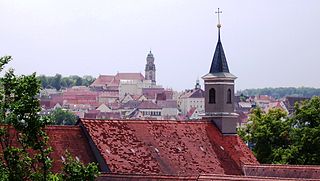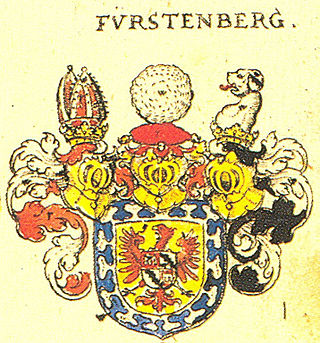Biography
Eitel Friedrich was the eldest son of Prince Johann Georg,Prince of Hohenzollern-Hechingen (1577–1623) and Countess Franziska von Salm-Neufville (d. 1619). His father placed particular emphasis on a good education and the prince was sent to the universities of Vienna and Ingolstadt for this purpose. Educational trips to Italy and France also followed.
Eitel Friedrich succeeded his father as Prince of Hohenzollern-Hechingen in 1623. He also commanded an infantry regiment in the service of Emperor Ferdinand II. Eitel Friedrich was loyal to the Catholic Church and therefore supported the Habsburg during the Thirty Years' War.
His power base,the Hohenzollern Castle,was strategically highly significant. The principality was surrounded by Protestant neighbors. In the war,the fortress developed into a focal point and was besieged and devastated by the Swedes and Württembergers in 1634. The castle was recaptured by Imperial troops the next year,and remained under Habsburg control until 1798 against a payment of 5,000 guilders annually.
The Thirty Years' War had impoverished the people in Hohenzollern-Hechingen and Eitel Friedrich was also faced with serious financial problems,forcing him to sell several attractive fiefs.
In 1653,Eitel Friedrich became a Prince of the Holy Roman Empire and was admitted to the Imperial Diet in Regensburg.
In 1661,Eitel Friedrich was wounded in ČeskéBudějovice and died shortly after. He left no male heirs and was succeeded as a Prince by his brother Philipp.

The House of Hohenzollern is a formerly royal German dynasty whose members were variously princes, electors, kings and emperors of Hohenzollern, Brandenburg, Prussia, the German Empire, and Romania. The family came from the area around the town of Hechingen in Swabia during the late 11th century and took their name from Hohenzollern Castle. The first ancestors of the Hohenzollerns were mentioned in 1061.

Hohenzollern-Sigmaringen was a principality in southwestern Germany. Its rulers belonged to the senior Swabian branch of the House of Hohenzollern. The Swabian Hohenzollerns were elevated to princes in 1623. The small sovereign state with the capital city of Sigmaringen was annexed to the Kingdom of Prussia in 1850 following the abdication of its sovereign in the wake of the revolutions of 1848, then became part of the newly created Province of Hohenzollern.

Hechingen is a town in central Baden-Württemberg, Germany. It is situated about 60 kilometres (37 mi) south of the state capital of Stuttgart and 90 kilometres (56 mi) north of Lake Constance and the Swiss border.

Hohenzollern-Hechingen was a small principality in southwestern Germany. Its rulers belonged to the Swabian branch of the Hohenzollern dynasty.

Sigmaringen Castle was the princely castle and seat of government for the Princes of Hohenzollern-Sigmaringen. Situated in the Swabian Alb region of Baden-Württemberg, Germany, this castle dominates the skyline of the town of Sigmaringen. The castle was rebuilt following a fire in 1893, and only the towers of the earlier medieval fortress remain. Schloss Sigmaringen was a family estate of the Swabian Hohenzollern family, a cadet branch of the Hohenzollern family, from which the German Emperors and kings of Prussia came. During the closing months of World War II, Schloss Sigmaringen was briefly the seat of the Vichy French Government after France was liberated by the Allies. The castle and museums may be visited throughout the year, but only on guided tours. It is still owned by the Hohenzollern-Sigmaringen family, although they no longer reside there.

Charles II, Count of Hohenzollern-Sigmaringen became Count of Hohenzollern-Sigmaringen in 1576 and remained so until his death. He was the fifth but second surviving son of Charles I, Count of Hohenzollern, and Anna, daughter of Ernest, Margrave of Baden-Durlach.
Eitel Friedrich may refer to:
Karl Friedrich was a member of the House of Hohenzollern and Prince of Hohenzollern-Sigmaringen, Lord of Haigerloch and Wehrstein from 1769 until his death.

Egon VIII of Fürstenberg-Heiligenberg was Imperial Count of Fürstenberg-Heiligenberg (1618–1635) and Bavarian Field-marshal, and an important military leader in the Thirty Years' War.
Johann Georg of Hohenzollern-Hechingen was the first Prince of Hohenzollern-Hechingen.

Count Eitel Friedrich IV of Hohenzollern was the founder and first Count of the line Hohenzollern-Hechingen as Eitel Friedrich I.

Prince Johann of Hohenzollern-Sigmaringen, was the ruling Count of Hohenzollern-Sigmaringen from 1606 to 1623. He was elevated to the rank of prince in 1623 and so was Prince of Hohenzollern-Sigmaringen from 1623 until his death.
Karl, Count of Hohenzollern-Haigerloch was the third Count of Hohenzollern-Haigerloch.

Eitel Friedrich II, Count of Hohenzollern was a count of Hohenzollern and belonged to the Swabian line of the House of Hohenzollern. He was the first president of the Reichskammergericht. As a close friend of the Archduke and later Emperor Maximilian I, he gained great influence in the imperial politics. He managed to consolidate and expand his own territory.

Prince George Frederick of Nassau-Siegen, German: Georg Friedrich Prinz von Nassau-Siegen, official titles: Prinz von Nassau, Graf zu Katzenelnbogen, Vianden und Diez, Herr zu Beilstein, was a count from the House of Nassau-Siegen, a cadet branch of the Ottonian Line of the House of Nassau. In 1664 he was elevated to the rank and title of prince. He served as an officer in the Dutch States Army, and was successively commander of Rheinberg and governor of Bergen op Zoom.

Magdalene of Brandenburg was a German noblewoman. She was a princess of Brandenburg by birth and by marriage a Duchess of Hohenzollern.

Jobst Nikolaus I, Count of Hohenzollern was a German nobleman from the Swabian branch of the House of Hohenzollern. He was the ruling Count of Hohenzollern from shortly after his birth until his death.
Philipp Christoph Friedrich, Prince of Hohenzollern-Hechingen was a German nobleman. He was the third prince of Hohenzollern-Hechingen.

Maria Elisabeth Van den Bergh, Princess of Hohenzollern-Hechingen was a Dutch noble woman and daughter of Hendrik van den Bergh. She lived in the court of Elizabeth Stuart, Queen of Bohemia in the year of about 1628.

Friedrichsburg Castle was a princely castle in renaissance style, situated in Hechingen, within the state of Baden-Württemberg, Germany. It was the residence of the princes of Hohenzollern-Hechingen. At the start of the nineteenth century, the castle was demolished and replaced by the ‘Neues Schloss’. Today, nothing remains anymore of the Friedrichsburg.














